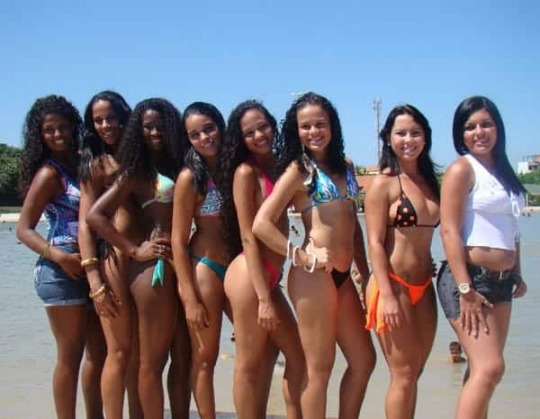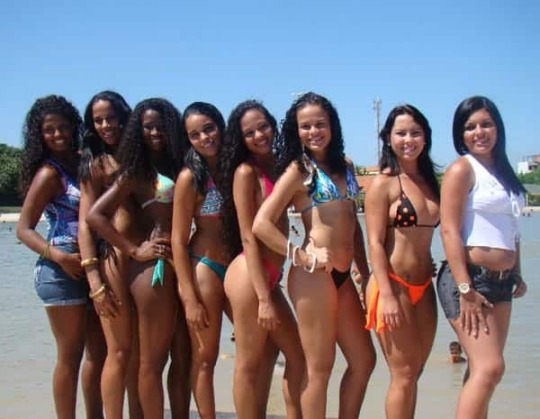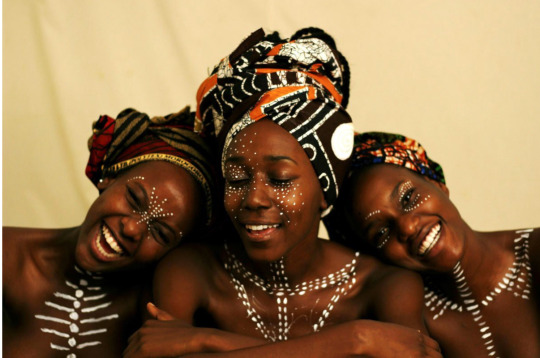#brazilianwomen
Photo

Da minha coleção de flyers & gigs! @xxxperiencebr Curitiba 2008 , com @johnphantasm e Junya (aka Eskimo) a convite do meu querido amigo @djfeiopsy 🔥 *Não lembro quem foi o fotógrafo, mas mandou bem 😄 _________________________ #flyers #seasonbookings #progressivehouse #technolovers #techno #musicproducers #djane #femaledj #brazilianwomen #djset #xxxperience https://www.instagram.com/p/CUvmrP_Mzuh/?utm_medium=tumblr
#flyers#seasonbookings#progressivehouse#technolovers#techno#musicproducers#djane#femaledj#brazilianwomen#djset#xxxperience
2 notes
·
View notes
Text
“Women, abandon the LGBT Movement”, by Furia Raiz (@furiaraiz), extracted from her personal page on the platform “Medium”

It is understandable that women believe they have shared goals with the LGBT “community”. After all, there are lesbian and bisexual women, and the community supposedly would include them in their activism. And it is a fact that gay men suffer with prejudice and that homophobia is a serious problem that still causes a lot of pain and death. The narrative of the LGBT movement is seductive - the inclusion of any and all “deviant” people under the umbrella concept of diversity, and the fight for rights and protection.
It is ignored, however, that the LGBT “community”, as a space to welcome anyone who does not conform to the dictates of compulsory heterosexuality, does not exist materially speaking. Every woman who has gone through the activist experience in LGBT spaces has experienced how all the themes are mainly about gay men and male sex. Lesbian and bisexual women do not even have their own issues recognized and this does not happen by accident. In patriarchy, the logic of maintaining the hierarchy between the sexual classes "man" and "woman" permeates everything, including the political left. Men will always be prioritized in all movements, except radical feminism (which for this reason is persecuted).
When lesbian and bisexual women realize that they are an ostracized part of the LGBT "community", the first impetus is the demand for real inclusion within the movement. This seems valid, but it ignores that the key points of this activism are incompatible with ideals of a true liberation for women, since in its development it encompassed ideals that pulverized any material analysis of the conditions that transformed non-heterosexual people into deviant and marked beings to be persecuted and punished. Without an understanding of the conditions provided by the hierarchy of sex classes in patriarchy, subsisting on a regime of compulsory heterosexuality, it is impossible to engage in a dignified and assertive discussion about sexuality. And by rejecting this bias (which is proposed by radical feminists) and making room for theories that embrace subjectivity at all costs, and inclusion without measure, in the end, the usual ones in this entire social configuration are harmed: women, who remain suffering from material exploration of their labor, emotional and reproductive sexual capacities.
A brief history
Sheila Jeffreys, in Unpacking Queer Politics, develops a well-founded history of the context of the new social movements of the 1960s, which was the stage for the rise of lesbian feminism. The gay liberation movement, in its origin, understood that homophobia was the result of patriarchy and only with its abolition would the oppression of gay men and lesbian women end. As a result, there was a fierce opposition to so-called sexual roles - stereotypes attributed to women and men who are socially constructed to maintain male supremacy - masculinity and femininity. The movement was also opposed to the sexual exploitation of gay men in the sex industry and did not refrain from questioning their own culture and how compulsory heterosexuality made them reproduce behaviors of domination and submission within their relationships.
"The oppression of homosexuals and the oppression of women were both seen as a result of the imposition of what was called "sex based roles ". (…) Thus, both liberationist gays and feminists viewed sex based roles, what is now probably called “gender roles”, as being politically constructed to ensure male domination. Women were relegated to female sex based roles in the private sphere, nurturing and caring for the beautification of the body in order to be an appropriate sexual object. Lesbians were persecuted because they challenged the female sex based role of sexual passivity and servitude to men. Gay men were persecuted because they challenged the male sexual role, which, in addition to requiring male behavior, was based on heterosexuality and intercourse with women.”
Sheila Jeffreys, Unpacking Queer Politics*
However, this debate soon gave way to another type of activism, which celebrated the harmful aspects of gay culture as an authentic experience of homosexuality. Masculinity, which was previously something to be destroyed, was strengthened to the point of creating a practice that Marilyn Frye, in 1983's "Politics of Reality: Essays on Feminist Theory", calls gay hypermasculinity - the exaltation of masculinity through worship of the phallus, for the hatred of women, among other factors. Misogynistic terms to refer to lesbians, the hatred of women's bodies as opposed to the worship of the phallus, the abandonment of feminist issues that leveraged the beginning of the movement: all this exhausted the lesbians who were trying to build together.
At the same time, the women's liberation movement also excluded lesbians. Betty Friedan called the lesbians who populated the feminist movement “the lavender threat” when they tried to include their issues, ignoring the fact that lesbians also fought for the most urgent issues of women who had relationships with men, such as abortion. Within this context, lesbian feminism emerged from the stampede of lesbian women from these movements, who deepened their analysis and contestation of male oppression and theorized about its annihilation.
"In fact, in the 1970s, and not without conflicts, the lesbian movement emerges and spreads throughout the world, assuming its autonomy at the same time in relation to feminism and the mixed homosexual movement, and more broadly in relation to “progressive organizations from which their activists frequently left.”
Jules Falquet, Breaking the taboo of heterosexuality. *
The gay community gradually lost its revolutionary character and resigned itself to seeking acceptance and inclusion in the presumption of male citizenship. Marriage, previously questioned as a mechanism for the domination and submission of women, became a goal. The social construction of sexuality, crucial for lesbian feminism, has been replaced by the discourse of innate sexuality. The movement stopped advocating for a radical change in society and became a shallow movement for civil rights.
It is important to note that it is much easier for gay men to abstain from a debate about structure, oppression and sex classes than for women, of any sexuality. Gay men are still of the male sex class, and therefore, although they are punished for refusing compulsory heterosexuality, they benefit from numerous privileges, and have not ceased to belong to the oppressive class of women. Their dissatisfaction with society, moreover, as Marilyn Frye points out, comes from the understanding that they would be equally deserving of the classic position of power of the heterosexual man, whose access is difficult to them (although not necessarily denied).
“Since the constituency of the male gay rights movement is very overtly and definitively classified and degraded as "womanish" or "effeminate," it might seem that a logical and proud gay political strategy would be to demand citizenship as "women"--the strategy of challenging the presumption of male citizenship. Some individual gay men lean toward this, and thus to political kinship with women, but the gay rights movement generally has taken the course of claiming the manhood of its constituents, supposing that the presumption of gay men's rights will follow upon acknowledgement of this. In so doing, they acquiesce in and support the reservation of full citizenship to males and thus align themselves with the political adversaries of feminism.”
Marilyn Frye, Politics of Reality: Essays on Feminist Theory
The shallow civil rights politics of the gay movement escalated with the emergence of Queer Theory in the 1990s, which embraced what is called gender as performance, rather than problematizing the existence of sexual roles. The logic of adopting the word queer, as an inclusion that ignores the specificities of women, was applied to the whole movement: more and more identities were created and included without question, based on the individual personality of its participants, who argued that they were political categories specific. Such theories were encouraged by extreme liberalism, which makes everything political about individuals, not classes.
The LGBT movement, as it is called today, has reduced the issue of sexuality to a moral issue, as if the conservatives who oppose them were merely defending “good customs”. They ignore that when conservatives defend the "family", they are defending a patriarchal institution for the exploitation of women. Thus, they state that any deviant is part of this struggle for pure and simple transgression, a transgression that, as Jeffreys puts it again in Unpacking Queer Politics, can only exist in opposition to moralism and does not really subvert patriarchal logic.
“Transgression is a delight for the powerful, who can imagine themselves delightfully disobedient. It depends on maintaining conventional morals. There would be nothing to offend and the delicious disobedience would disappear if a serious social change happened. Transgressors and moralists depend on each other in a binary relationship that defeats rather than allows for change. In addition, transgression depends on the existence of subordinates over whom sexual transgression can be dramatized. It is not a viable strategy for the housewife, the prostituted woman or the abused child. These are objects of transgression, not their subjects”.
Sheila Jeffreys, Unpacking Queer Politics*
The current LGBT movement is the result of the gay movement's betrayal of feminist and / or lesbian women, and its resignation to liberal and capitalist concepts, which viewed them and see them as a market niche. They claimed the word queer as an umbrella term for all deviants, ignoring that lesbians needed to fight for the denomination of women who loved women exclusively and for the inclusion of their existence in the gay male movement. Sheila Jeffreys puts on this point in Unpacking Queer Politics:
“Those who were most outraged by the new term were lesbian feminists, who noted that while the term was supposedly inclusive, it seemed to specifically exclude lesbians and lesbian feminists. Lesbian experience has been that generic words for male and female homosexuality quickly came to mean only men. Entire books were written by gay writers on "homosexual history" or "homosexual desire" in which lesbians were not mentioned (Rowse 1977; Hocquenghem 1978). The words "homosexual" and "gay" did not begin to mean only men, but started to do so as a result of a simple material political reality, of the greater social and economic power of men, of the power that allowed men to define what culture it is and makes women invisible. For lesbians, having a specific name for women who love women has been crucial in asserting the existence and difference of lesbians and in asserting lesbian pride based not on being an inferior variety of gay men, but on wild and rebellious women who refuse the status of subordinate. In fact, lesbian feminists have struggled hard for twenty years to put the word they chose to express their specific and different history, culture, practice and politics on the political map. (…) The adoption of the word “queer” changed all that. The fight to include the word "lesbian" was barely won when the tables were turned and the lesbians were buried again under "queer".”*
Old tactics
The vague inclusion narrative of the LGBT movement attracts women mainly because they were taught to empathize, which makes it difficult to refute someone else's claim that they need to be included in all spaces when that claim is based on emotional blackmail, not arguments. It is a very ingenious trap of patriarchy, which as always adapts to women's resistance. Socialization for femininity is used against the female sex class to keep them silent about claims they don't even know if they really agree with. Some of the means by which the LGBT movement not only does not include, but undermines the feminist struggle, will be listed below.
Assimilation
“In order to live their bodies, exercise their sexuality and simply live, women find themselves in much less advantageous conditions than men, even though they are homosexuals. Using the term "lesbian", therefore, avoids confusion between practices that, although are all homosexuals, do not have the same meaning at all, the same conditions of possibility or above all the same political reach according to the sex of those who carry them out.”
Jules Falquet, Brief Review of Some Lesbian Theories*
To assimilate lesbian and bisexual women under the idea that all deviants form a “community” is to achieve uncritical maneuver mass, used to advocate for the empty causess that benefit male people to the detriment of women. Women in the LGBT movement rarely know their own causes. Many still claim to be gay, or do not use the term lesbophobia because they think it is the same thing as homophobia. Many believe that gay men suffer more oppression than they do and ignore that violence against lesbian and bisexual women is barely accounted for. Corrective rape, fetishization, economic marginalization of lesbians read as male - none of this is addressed.
There is no materiality in the discourse of the LGBT movement. Assimilating so many different causes in an uncritical mass makes the new identities claimed also demand the appointment of new and innumerable forms of oppression, creating cracks among women. Currently, there is practically a war between bisexual and lesbian women within the LGBT movement, a war that male people not only do not problematize but encourage. This war is not by accident - it is not for nothing that those who are fighting within the community narrative are women. Undermining unions among women serves the patriarchy.
The community discourse is so seductive that speaking against it is considered exclusion. But exclusion from what? The feminist movement? From the LGBT movement? The left-wing struggle? All of these movements are mixed up, apolitical, under the liberal logic that everyone must fight against all oppressions, preventing women from focusing on fighting for the female, of all ethnicities, of all sexualities. It is not for nothing that the LGBT movement ignores sexual classes: this material reality creates a transversal in what they call the community, threatening their assimilationist causes.
“A culture hostile to any but missionary sexuality is also hostile to women--the culture is a sexist, a misogynist, a male-supremacist culture. Because of this cultural reality, the worlds of what the clinicians would call "homosexual" women and men are very different: we deviate from very different norms; our deviations are situated very differently in the male-supremacist world view and political structure; we are not objects of the same phobias and loathings. If some of us feel some threads of sympathy connecting us and therefore would want to be friends to each other's causes, the first thing we should do is seek a just understanding of the differences which separate us. But these differences turn out to be so profound as to cast doubt on the assumption that there is any basic cultural or political affinity here at all upon which alliances could be built.”
Marilyn Frye, Politics of Reality: Essays on Feminist Theory
Reformist and misogynistic guidelines
"Currently, the lesbian-homosexual movement is fighting for equality, especially for the right to marry and start a family, to incorporate the lesbian or homosexual couple within the parameters of the reproductive couple, symbolically building the "happy family""
Margarita Pisano, Homo-lesbian love*
It has been said that the LGBT movement has lost sight of issues such as the end of marriage and the end of the family, which have been feminist issues since the beginning of the movement. The family is an institution, which hides under the romanticization of affective bonds the fact that it is used to exploit women. This conception of LGBT family is used to legitimize the right to paternity of gay men, even if this is justification for the reproductive exploitation of women. The LGBT movement defends surrogacy, a practice that exploits poor and racialized women. This is a misogynist practice in its essence.
“So whose rights are we talking about here? We need to be talking about the rights of poor women, of women whose poverty or desperation is caused by structural racism, of the disabled rejected because they did not fit the model of the perfect baby; of women once again subjected to misogyny.”
Susan Hawthorne, Questions of Power and Rights in Surrogacy
Lesbian feminism politicized sexuality itself, understanding that it is not natural, or biological, but built in a patriarchal society. The conception that sexuality is socially constructed is, in addition to being correct, crucial to the radical feminist analysis of society. The LGBT movement departs from this premise when it defends that deviant people are born that way, hiding in the narrative that they are not to blame for their own deviance, and seeking to accept this biological coincidence. It is a more palatable rhetoric and, as always, nothing revolutionary. This type of discourse is useful for gay men, mainly, in the search for the reformist acceptance of gay men in the status of male citizenship - but, at the same time, it harms the struggle of women, who will never be a priority within a mixed movement.
The personal is political
"There are now whole areas of the women's, lesbian, and gay communities where any critical analysis of sexual practice is treated as sacrilege, stigmatized as "political correctness."
Sheila Jeffreys, How orgasm politics has hijacked the women’s movement
The LGBT movement stops the reflection upon its own practices, celebrating them regardless of what they mean politically. The impossibility of analyzing sexual practices makes the liberation of women impossible. Patriarchy works through the personal relationships of the dominated and the dominant; Carol Hanisch coined the term personal is political, in 1969, in an attempt to politicize power relations in the private space.
From the LGBT discourse, sexual pleasure - and only it - is the way to measure whether a sexual practice is healthy or not. It is ignored that patriarchy builds our sexuality for the eroticization of submission and domination, which means that we need to analyze the meaning of our pleasure politically. The LGBT movement celebrates BDSM as a healthy and consensual practice, ignoring the fact that the eroticization of violence is more of the same patriarchal logic.
“The sadomasochistic concept of “vanilla” sex is sex devoid of passion. They are saying that there can be no passion without unequal power. That feels very sad and lonely to me, and destructive. The linkage of passion to dominance/subordination is the prototype of the heterosexual image of male-female relationships, one which justifies pornography. Women are supposed to love being brutalized. This is also the prototypical justification of all relationships of oppression—that the subordinate one who is “different” enjoys the inferior position.
The gay male movement, for example, is invested in distinguishing between gay sadomasochistic pornography and heterosexual pornography. Gay men can allow themselves the luxury of not seeing the consequences. We, as women and as feminists, must scrutinize our actions and see what they imply, and upon what they are based.
As women, we have been trained to follow. We must look at the sadomasochistic phenomenon and educate ourselves, at the same time being aware of intricate manipulations from outside and within.”
Audre Lorde, It's not about condemnation
Through the same narrative of pleasure, the LGBT movement refuses to analyze the sex industry as a sexual exploitation of poor and racialized women, despite numerous feminist analyzes on the subject. It is yet another example of how neglected the issues that are crucial to women's lives are.
Reproduction of masculinity and femininity
“The lesbian / homosexuality experience lived by a person, whose mind and body are impregnated (colonized) with an essentialist patriarchal ideology, is not a liberating experience in itself, since it reproduces the patriarchal symbolic / valoric order, reproduces the property over people and reproduces the patriarchal love / hate system.”
Margarita Pisano, Homo-lesbian love
In the same logic of preserving the private space as free of politicization, the reproduction of femininity and masculinity within homosexual and lesbian relationships is seen as something natural, a common and questionable LGBT practice. While the gay liberation movement understood that it needed to end masculinity, the LGBT movement today celebrates sexual roles that reproduce heterosexuality within same-sex relationships. It is the logic of the active/passive, predator/prey, butch/femme, domination/submission again eroticized and naturalized.
Gay men claim masculinity and hatred of women. Marilyn Frye also analyzes the reproduction of theatrical femininity of gay men as a mockery of traditional women. To create a show based on a mechanism of domination of women is to emphasize that gay men, no matter how much they reproduce it, will never be affected by this mechanism, who are exempt from being forced into this role as are women. Again: transgression is a delight for the powerful.
“The male homosexual collective, in turn, exacerbates the patriarchal construction of masculinity in its most phallic expressions; by loving and eroticizing with a man, they do it with an equal, from power to power. However, they too incorporate patriarchal love symbolism (the female / male roles), when they allude to the stereotype of the female that historically implies the ridicule and humiliation of women.”
Margarita Pisano, Homo-lesbian love
Gender and compulsory heterosexuality
“The gender version introduced by lesbian-and-gay theory is very different from the gender concept of feminist theorists. It is a depoliticized, aseptic and difficult to associate with sexual violence, economic inequality and the fatal victims of clandestine abortions. Those who consider themselves too distant from the harsh details of women's oppression have rediscovered the genre as a game. And that perspective is well received in the world of lesbian-and-gay theory because it presents feminism as fun, not an irritating challenge.”
Sheila Jeffreys, Lesbian Heresy*
Gender understanding - and the exaltation of the word - of the LGBT movement is incompatible with feminism. It is propagated as performance, identity, essence; not as a mechanism for the domination of women. The feminists and lesbians who theorized male domination did not even use that term: what is called gender today, within radical feminism, used to be called sexual roles.
The biggest consequence of this for lesbians is the end of sexuality as it has always existed: based on sex. Currently, gender-based sexuality is defended, and numerous new identities have been created, supposedly “sexual orientations”, most of which are not even concerned with those who are attracted to them. This means that lesbian women can no longer claim their attraction to women without being accused of being oppressive for not including men.
This phenomenon is called the cotton ceiling, cotton being an allusion to the barrier that is the underwear of lesbian women to male access. The LGBT movement, in defending that lesbians are forced to attract people of both sexes, practices corrective rape; lesbian women give in to the pressure of being accused of oppressors and include male people within their possible sexual partners.
“Gradually, older terms to describe this system, such as male domination, sex class and sex caste, went out of fashion and, consequently, the direct identification of the agents responsible for the subordination of women - men - could no longer be appointed. Gender, as a euphemism, erased men as agents responsible for male violence against women, which is commonly referred to as "gender violence". Increasingly, the term "gender" is used, in official forms and legislation, for example, to replace the term "sex", as if "gender" itself is biological, and that use has destroyed the feminist understanding of gender.”
Sheila Jeffreys, Gender Hurts*
Backlash
“The analysis of reality from the current culture and its proposals, is a reality that does not exist for us, it is a reality where we have never been, nor will we be, nor are we, nor does it belong to us as an analysis, so we must review very carefully the need to adhere to any analysis or proposal for change that does not come from ourselves, recover our own reflections, our own political history, as we obviously do not have the same interests as other marginalized groups; we can make circumstantial alliances, but not let our speech be taken by others, lost in others.”
Margarita Pisano, Lesbian incidences or the love of one's reflection*
The current LGBT movement ignores what lesbians wrote and theorized about their own oppression. Access to this knowledge by lesbian and bisexual members of the movement is barred. Anyone who dares to disagree with the countless misogynistic practices it carries is accused of being oppressive. It removes the autonomy of women to define their own nature. There is no way not to define it as backlash - the reaction of the patriarchy to the women's liberation movement.
Women, abandon the LGBT movement. Prioritize yourself. Do not spend your energies demanding inclusion in an essentially liberal movement - and focused on men. Acknowledge the backlash. Do not be afraid to be accused of oppressors for pleading for a feminism that does not include male people. Women are already hated and will always be until patriarchy is overthrown, and the only really revolutionary path is that of radical feminism. Subvert femininity - do not practice the mothering of all and any person who claims to be oppressed. Empathize with other women. Do not listen to the guilt that does not belong to you.
Women, abandon the LGBT movement. Study lesbian feminism. Honor those who came before you.
"But the real feminist deals with a lesbian conscience whether or not she has ever slept with a woman."
Audre Lorde, Being a black lesbian feminist*
_________________________________________________________
Notes from the translator.
*All the quotes marked with this symbol were originally written in Spanish or English by their authors. However, in this original essay, in Portuguese, the quotes were not in Spanish or English, but already translated into Portuguese. I do not have access to the original version of these quotes in Spanish or English to include them here, so what I did was translate them into or back into English from the Portuguese-translated version. All of this is to say that these quotes might not be, word by word, exactly equal to the original quote in Spanish or English, even if they were originally written in English in the first place.
Original text: Originally available at: https://medium.com/qg-feminista/mulheres-abandonem-o-movimento-lgbt-c8fe1d4d98e9
#lgbt#lgbtmovement#radicalfeminism#lesbian#brazilianwomen#womenwhowrite#womensrights#lesbiansrights#radexporta
8 notes
·
View notes
Photo

🍑Sometimes I grab my own butt... Becuse well, I squat💋 #brazilian #brazilianwomen #latina #afrolatina #photoshoot #chicago (at Chicago, Illinois) https://www.instagram.com/p/B5gUgbdBr0b/?igshid=lpf1twl4h5lz
3 notes
·
View notes
Text

Bruna Marquezine and Giovana Ewbank.
77 notes
·
View notes
Photo

Barbara’s body.
4 notes
·
View notes
Video
Happy Bitthday to Me! 😍40 years old but still a rebel😍 #birthday #champagnelifstye #veuveclicquot #40yearsold #nyc #urbanroyalty #brazilianwomen #childfree #singlelife #luckyaf #happybirthdaytome #livingmybestlife #eastvillage #alphabethcity (at East Village, Manhattan) https://www.instagram.com/p/BrYU2HTFcwh/?utm_source=ig_tumblr_share&igshid=3tbul114iuwk
#birthday#champagnelifstye#veuveclicquot#40yearsold#nyc#urbanroyalty#brazilianwomen#childfree#singlelife#luckyaf#happybirthdaytome#livingmybestlife#eastvillage#alphabethcity
3 notes
·
View notes
Photo

TUNE IN to the Speak Your Truth Show, 4-6pm (uk time), today Saturday 27 March, when I will be in conversation with the splendid Sista Thilá Nascimento, Program Associate at the Ford Foundation in the Brazil Office. Born and raised in the city of São Paulo, Sista Thilá has an undergraduate degree in International Relations, a Masters in Social Sciences and has worked in the NGO sector. The focus of her work has been on youth and disabled people’s issues. Her career began as a university research assistant in a project funded by IWGIA, later going on work as a management analyst. She is passionate about Arts. Engaging Conversation Eclectic Music A Pan Afrikan Perspective We love to hear from you so give us a call, WhatsApp or text us on +44730 541 7668 or leave your comments in the comment box. http://www.feferitylondon.co.uk/feferity-radio/ https://m.mixcloud.com/Feferityradio/ #ngo #philanthropy #afrobrazilian #saopaulo #arts #brazil #brazilianwomen #blackbrazil #brazilianart https://www.instagram.com/p/CM7CM7shMvf/?igshid=1nuua83659wld
0 notes
Photo

Tips For Attracting Brazilian Women For those of you who are interested in ......Read the rest by clicking the link below! https://worldwidetweets.com/tips-for-attracting-brazilian-women/?feed_id=7183&_unique_id=60293a2ca4347
0 notes
Photo

Tips For Attracting Brazilian Women For those of you who are interested in ......Read the rest by clicking the link below! https://worldwidetweets.com/tips-for-attracting-brazilian-women/?feed_id=7182&_unique_id=60293a2be3f4e
0 notes
Video
Eu fikei rouca pq sou alergica à fumaça, não ia conseguir fazer o quarto show do FDS sozinha, e ela não pensou duas vezes em me ajudar - mesmo estando extremamente cansada - a executar esse show ke ela nunca nem assistiu inteiro!!!! Isso é parceria, isso é irmandade, isso é amor!!!! Agradeço à Deus por ter vc como minha irmã e por estar aki pra mim, como eu sempre estou pra vc!!! Te amo, @vanessajacksonoficial!! Muito obrigada, famêlea #SP3 e @a_bannda pela compreensão e apoio, amo vcs tb!!! ❤🎤🎶🎙🎵 #sisterhood #family #sp3 #abannda #showtime #blessed #singers #music #musicians #livemusic #band #voices #ilovemyjob #godisgood #instruments #joy #love #blackgirlmagic #hairstyle #art #artists #microphone #africanqueens #divas #brazilianwomen #backgroundsinger #backingvocal #performers #entretainers #musicianslife #blackhair (em Hotel Unique)
#musicians#singers#sisterhood#entretainers#blackgirlmagic#brazilianwomen#abannda#sp3#divas#showtime#artists#livemusic#love#instruments#backgroundsinger#blessed#ilovemyjob#africanqueens#family#joy#blackhair#backingvocal#hairstyle#godisgood#performers#musicianslife#band#music#voices
1 note
·
View note
Photo

Amigo! 💞 A boa filha, a casa torna! @danghaiclub 🔥 @calebernardi #danghaiclub #seasonbookings #topnightclubs #bestnightclubs #progressivehouse #technolovers #time #musicproducers #djane #femaledj #brazilianwomen #thuglife #djset #freakishdjlife #djlifestyle #freakishdjlife #boss #partner #amigos https://www.instagram.com/p/CS59hvYMk-v/?utm_medium=tumblr
#danghaiclub#seasonbookings#topnightclubs#bestnightclubs#progressivehouse#technolovers#time#musicproducers#djane#femaledj#brazilianwomen#thuglife#djset#freakishdjlife#djlifestyle#boss#partner#amigos
3 notes
·
View notes
Text
“What is Sorority? – Learn about the meaning of the political tool and its social unfolding”, by Yasmin Morais (@vulva_negra), extracted from her personal page on the platform “Medium”.

Photograph by: Mimi Mutesa
This article is protected by Creative Commons CC BY-NC-ND, which only allows it to be utilized as long as credit is given to the author, but without it being altered in any ways or used for commercial purposes.
This term has been placed in the pedestal of curiosity, beginning in the year 2017. Recently fomented in Brazil, the phrase “What is Sorority?” had been one of the most asked questions made by Brazilians in Google’s tool, according to the ranking of the digital search engine itself. Becoming extremely popular, the notions of “Sorority”. populated magazines, videos published on youtube, tv shows and became the standard in the discourses of any digital influencer.
After translating into wide adhesion, the term was quickly coined by the Liberal tendency, which had highlighted the metaphysical characteristics of the supposed feeling which would edify an alliance among women. Tending to a particularly simplistic analysis, the term which had that did the accomplishment of projecting itself beyond the activism bubble, suffered a constant emptying of its revolutionary meaning. In this sense, Sorority had become the target of immense criticism in feminist academic productions and intersectional perspectives.
“Sorority for whom? What I have seen a lot in the feminist movement is sorority only towards one’s own kind - white women practicing it with white women, for example, and with black women there is no idea of complicity. Often, the idea of sorority is used to silence one, especially when a person that does not have priority to speak on a given subject uses sorority in a debate to silence another person [...] ”.
- Scarlett Rodrigues da Cunha, Master's Student in Public Policy at Universidade Federal do ABC
Potential restlessness proliferated, turning the term into an unknown polysemic. After all, is Sorority unilateral? Was it a feeling? Political action? It will be my crucial objective to bring such questions to light.
Sorority: An Alliance among Women?
Sorority is the Lusophone variation of the term derived from the Latin sóror = sister. Coined as a political nomenclature, its significance would be an opposition to the term fraternity, which would designate the union between male human beings
Sorority would be described as a political, social and cultural alliance between women, who, because they understand empirically the implications of belonging to the female sex in a patriarchal society, would share specific experiences with each other. In this way, sorority emerges such a feeling theoretically common to all women, which, at its core, has the potential to build bridges between the most varied female classes. However, it should be noted that, from a radical feminist perspective, sorority as a “common feeling” among women, would not be something sufficiently capable of promoting the revolution that is being proposed.
When the second-wave feminist movement emerged between the 1970s and 1980s, the term sorority was not even used to designate the alliance established between different niches of American women who cried out for the weakening of sexism, the end of gender stereotypes, the acquisition of rights, the end of wage inequality and other oppressions related to the female class. Initially, the proposal for solidarity among women had emerged beyond subjective borders and had become a political, social and cultural desire.

Greek ceramics (unknown) portraying an Amazon, a human female that integrate an old, matrilineal and warrior nation according to Greek mitology.
Feminism, in its libertarian essence, called for the notions of archetypal union among women, which recalled the power of the female class when united in pursuit of a common goal. Historically, the conception of females, who held power and lived under the emblem of a matrilineal community, had been edified on countless civilizations. The Amazons, Valkyries and the Daomé Warriors, together project archetypes related to the strength arising from the female union in different cultures and historical periods.
However, sorority posed intrepid challenges to those who did not have a real desire to establish solidarity among all female classes. For, sex as a constituent category of the class, is intertwined with the categorizations of race and social class, which produce and sustain different levels of oppression among women. In this way, black women remain historically vulnerable and politically inferiorized to Caucasian women. A supposedly equitable alliance among women, could never be established, if racism and female classism were not strongly faced. However, at that time, several Caucasian feminist groups maintained perspectives entirely directed towards sex, excluding demands related to racialized women.
Significantly, sisterhood (sorority) could never have been possible in all the limits of race and class, if individual women were not willing to alienate their power of dominating and exploiting subordinate groups of women. While women are using the power of class or race to dominate other women, feminist sisterhood (sorority) cannot be fully realized.
- bell hooks, “Feminism is for everyone”
In this way, the utopian and discriminatory potential in which sorority was initially interpreted and applied by activists is displayed. For, through structural racism, such Caucasian women allocated themselves as a unique and representative expression of the female class, neglecting social movements which removed from them the ethnic-racial and economic power to oppress. The dematerialization of the political alliance is an imminent danger. After all, when political experiences are reduced to feelings, which belong to an intangible nature, the materiality of political action is compromised.
Sorority: Brief History of Female Alliances
Throughout history, alliances made up of women in the face of patriarchal oppression have shown themselves to be diverse. At the heart of countless civilizations, human females jointly challenged the social dogmas which corroborated the maintenance of the male yoke. From the occurrences in the mythical imaginary, to the female resistance during the Early Middle Age and the groups of women who rose up against oppression in the Middle East, the female potential has always been stimulated by the desire for revolutions or social non-submissiveness.

“The Witches” by Hans Baldung (1510). In the painting, one perceives the misogynistic and stereotyped conception in which the imagery of the “medieval witch” was constituted. Elderly, naked females riding winged brooms and summoning devils. The demonization of women was a useful tool for the institutionalization of female genocide.
However, the operation inherent in the patriarchal organization, has constant discursive battles. Under hegemonically male dominance, History is told in distorted ways, which favor the female dispute and the slanderous archetypes which have historically been attributed to women. Since Christian domination in medieval Europe, the demonization of pre-Christian religious practices and the female class, had made the alliance among women a symbol of the satanic uprising which should be continually combated. United, women cared for each other, even though they were politically accused of organizing satanic sabbaths and secret demonic associations.
Undoubtedly, the alliance among human females evokes ancestral symbologies in cultures from all the known civilizations. Having been linked to the great acquisition of power, the movements which were self-organized by women, caused extreme fear in the existing patriarchal systems. The female who chose to abandon phallic worship and turn to her own kind was personified as a traitor; heretic which needed to be severely punished. Through the constitution of strict hierarchies among women, in which those who loved insubordination were completely demonized and those who were submissive to the male and Christian yoke were considered devout women, the bitterness towards female associations, had historically been sown in the psyche of women. which maintained the belief in patriarchal providence.
In the 21st century, minor adaptations took place. However, the core of such behavioral hierarchies, remains on its usual podium. The insubordinates are no longer witches, warriors or sorceresses, however, women who stand up vehemently in favor of female emancipation and do not commune with patriarchal subservience. However, under the face of a liberal revolution, devout women have subsisted, becoming those who do not yearn for trustworthy emancipation.
The Problematics of “Horizontal Hostility”
“It was to be learned that the oppressed can also be oppressive. Not only can the oppressed share, even if minimally, the status and privileges of the dominant at the expense of other oppressed ones.”
- Denise Thompson, "A discussion of the Horizontal Hostility problem".
It is necessary to conceive the lacerating premise, which they constantly obscure: “women have status passible to oppression, they can use certain privileges related to class and race to override others. Certain women corroborate and work for the current system”. The processes of female socialization in a primarily patriarchal system, are based on the gradual alienation of female associations and belonging to the class.
The human female, socialized as such, submits to the frequent annulment of Being as a powerful and emancipated instance in the world. In this way, from disciplinary mechanisms which train psychically and physically, women are instructed in an indisputably phallic-patriarchal hierarchy. In this one, the male and instances conceived as masculine, allocate themselves in the antagonistic apex as dominant, therefore, the female and instances conceived as feminine, relegate themselves to socially undesirable, rejected and vexatious positions.
Within the scope of this premise, the human female, whose unconscious is attentive to the socio-symbolic inferiority attributed to her sex, craves the acquisition of power in the social structure, through reproducing of socializing perspectives raised from the male perspective. In the homonymous article produced by the theoretician Denise Thompson, entitled “A discussion of the problem of horizontal hostility”, the oppressive dynamics which emerge in the socio-cultural circles experienced by women are explicit.
"Horizontal hostility is the best method of the heteropatriarchy to keep us in 'our proper places'; we do the work of men and their institutions for them… (…) it makes us direct our anger - which arises from our marginal and subordinate status in heteropatriarchy and which should be directed at our oppressors - at other women, because we know that it is safer … ”— Penelope, 1992 in “a discussion of the horizontal hostility problem”.
Thus, in addition to the stratification promoted by the Racial and Economic Hierarchy, fragments of female socialization culminate in behavioral action that is opulent in envy, sabotage, hatred, competition and subordination among women. After all, at the heart of a patriarchal society, the human female engages, consciously and unconsciously, in the struggle for male approval which, in the light of such a system, would provide her with divinized social redemption. However, it becomes explicit that only a select class of women will be able to ascend to patriarchal molds, thus generating the perfidious atmosphere in which females fight each other, while male hegemony feeds back and strengthens itself through its efforts.
A Treat for a Possible Sorority
It is imperative to abdicate to the liberal and reformist perspectives currently in force in the mainstream conception of sorority. After all, the inhospitable rescue of the mystical notions of alliances established by women, vetoes the political, organizational and materialistic potential held by such links. There is no feeling common to human females. Nor there are equitable and homogenized relationships between women. To raise the gynocentric ancestral perspective is the ground zero of the establishment of a possible sorority. For it is only through a confrontation with the androcentric conception that a real alliance between women can be conceived.
Socially, women are indoctrinated to live the human experience in the light of a male interpretation. The male as an archetype, shows himself as the great carrier of humanity, wisdom, justice and beauty in its highest degree. Only him can antagonize with other males, which establishes himself as a protector. In this way, women are socialized so that they prioritize the relationships they establish with men. Females are alienated from their revolutionary potential, which develops greatly when in assembly. We are led to the perception that other women are the perfidious antagonists who wish to take from us the miserable crumbs offered by the patriarchal regime.
A rupture with male hegemony runs through psychological, socio-cultural and economic instances. Women's groups, when not psychologically, are financially and politically sabotaged. However, the traps structured by the Patriarchy, through female socialization and the establishment of dark archetypes about the Female Being, haunt us and lead us to socio-political isolation or superficial relations with other women. We need to revisit the circles we have entered into and rescue the principles of the female community. It is notorious to establish an anti-racist, anti-sexist, anti-lesbophobic and gynocentric political alliance.
Admitting to having privileges related to race and class and, in fact, addressing the structuring of associations in which women and children become politically, socially and economically prioritized, will lead to a future in which, undoubtedly, a society in which the alliance between women rises in all its revolutionary drive can be structured. There will be no sorority as long as it is not possible for us to cry out against the oppression experienced by other women and dedicate ourselves to building a truly emancipatory and intersectional socio-political movement.
HOW TO CITE THIS ARTICLE ACADEMICALLY: MORAIS, Yasmin. “O Que é o Sororidade?”. Medium, 2019. Available at: <URL>. Access in: day, month and year.
_________________________________________________________
Originally available at: https://medium.com/qg-feminista/o-que-é-sororidade-5ce259b53a98
#radexporta#sorority#radicalfeminism#brazilianwriter#womenwhowrite#womensrights#feminism#womensmovement#brazilianwomen
8 notes
·
View notes
Photo

🍒Be brave, be kind, be you #brazilian #brazilianwomen #latina #afrolatina #photoshoot #chicago (at Chicago, Illinois) https://www.instagram.com/p/B5gS4oOBzzt/?igshid=i74ankfuv5is
1 note
·
View note
Photo

Step out, step in, It's windy but warm. Love is all around us, Summer nights, city lights. Comfort fit in the golden light. @izarocche #comfortfit #bodysuitlingerie #summernights #brazilianwomen #capetowncity (at Cape Town City) https://www.instagram.com/p/B9PhGl8pgmh/?igshid=17l8xtap0dtig
0 notes
Photo

it was a happy day.
4 notes
·
View notes
Photo

Busy Sunday doesn’t have to be a boring Sunday... #bloodtestanalysis #hemoglobin #hematocrit #neutrophils #lynphocytes #vaping #treebaseklear #thccartridges #icedcoffee #lioncoffeevanillamacadamia #konacoffee #hawaiiancoffee #sunday #tanning #urbanroyalty #brazilianwomen #firstdayofspring2018 #byewinter #summeryourbeatifulbitch https://www.instagram.com/p/BoE0kwUFyuE/?utm_source=ig_tumblr_share&igshid=kh7qs4t8a51s
#bloodtestanalysis#hemoglobin#hematocrit#neutrophils#lynphocytes#vaping#treebaseklear#thccartridges#icedcoffee#lioncoffeevanillamacadamia#konacoffee#hawaiiancoffee#sunday#tanning#urbanroyalty#brazilianwomen#firstdayofspring2018#byewinter#summeryourbeatifulbitch
2 notes
·
View notes